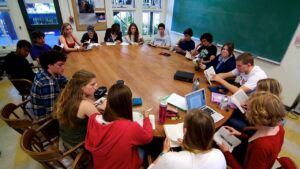Student, in a cooperative learning classroom, consistently score higher on individual tests. What occurs to allow student achieve higher individual scores?
First of all, cooperative learning is not placing student in a group and expecting them to learn. A teacher needs to set up rules, regulations and jobs within the groups. Students should be fully aware of how the group works.
Modeling behavior and practicing group behavior takes from one to two weeks of instruction. The students have to believe that their group is dependent on each other, in order to succeed.
There are two categories of interdependence.
- One is “outcome interdependence”. Without a goal or a reward at the end of a project, there is no incentive.
- The second category is “mean interdependence”. This where each member is responsible for resources and tasks that complete the group activity.
Without these two categories, the group will not succeed nor will the group learn.There are five major tips that will make cooperative learning successful.
1. Interdependence
Students must feel that unless they work together to achieve a goal, they will fail. Studies show that students who feel responsible for their task to make the group successful, work harder. Each student’s contribution is significant, which makes the student feel unique and effective.
2. Encouragement interaction
This sounds easy, but it takes a lot of preparation to achieve. This is when student:
- encourage each other and try to help each other to complete each task
- share materials, information, and help with clarifying each other’s tasks
- give feedback to improve each other’s work, so the group reaps the reward
- knowledge that members in the group are helping and not judging
- teaches trust and motivation
3. Individual responsibility
This involves the student completing their task for the group to achieve their goal.
The student is accountable to the teacher, who will give an individual evaluation as well as a group grade. The student is also accountable to their peers.
The teacher hands out expectations (rubric) and points for the task given the group and each student.
4. Small group skills
To reiterate, a teacher cannot just put a student in a group and expect them to know what to do.
- The students must learn leadership and communication skills.
- The students who are not skilled socially learn how to become adept in social situations.
- The small groups can be trained to work in groups.
- The students are trained weekly in social skills.
- The students are then quizzed on the skills they learned.
If the individual group members work together, using learned social skills, they are exempt from the quiz.
If three out of four members work well together, the group receives 2 points extra credit given on the quiz. The groups are given practice tasks to check on their mastery by teacher observation.
5. Group processing
This is an integral part of cooperative learning.
The students assess themselves and their group members on how they worked together. It is a reflection of whether the students were effective or ineffective.
Decisions on actions that worked or did not work.
Decide if the actions of the group’ interactions worked or could improve. This aspect is extremely valuable. It allows students to understand how their actions helped the group.
They can discover the areas that need to be improved to be a productive member of the group. It is highly recommended that students continue this reflection after each task assignment.
Final Word
Cooperative learning is the best approach to student learning.
It helps students who have difficulty with a concept to understand at a deeper level.
Studies show that of all the learning modes: cooperative, competitive, and individual learning, that achievement is higher in cooperative learning.
The students, when tested individually, showed higher scores on tests.

